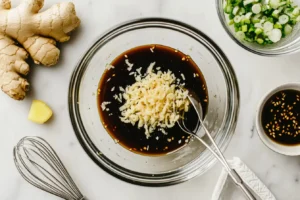When it comes to elevating your meals with minimal effort, few things rival the magic of a homemade dressing. This miso ginger dressing recipe combines the bold flavors of miso paste and fresh ginger to create a perfectly balanced sauce that’s tangy, umami-rich, and slightly spicy. Whether you’re drizzling it over crisp salads, using it as a marinade, or serving it as a dipping sauce, this versatile recipe will quickly become a staple in your kitchen. In this guide, we’ll explore everything you need to know—from understanding the origins of this dressing to crafting it step-by-step. Let’s dive in!
What is Miso Ginger Dressing?
Understanding Miso Ginger Dressing
 This delightful dressing brings together the umami punch of miso and the warm, zesty notes of ginger, offering a harmonious blend of flavors. But what makes it truly special is its versatility—it’s a game-changer not just for salads but also for marinades, dipping sauces, and beyond.
This delightful dressing brings together the umami punch of miso and the warm, zesty notes of ginger, offering a harmonious blend of flavors. But what makes it truly special is its versatility—it’s a game-changer not just for salads but also for marinades, dipping sauces, and beyond.
The Origins of Miso and Ginger in Culinary History
Miso, a fermented soybean paste, hails from Japan and has been a cornerstone of Japanese cuisine for centuries. Its rich, salty, and slightly sweet flavor adds depth to countless dishes. Ginger, on the other hand, is a global culinary treasure. From Asia to the Mediterranean, ginger has been prized for its bright, peppery bite and its health benefits, such as aiding digestion and fighting inflammation. Together, miso and ginger create a timeless fusion that brings the best of Japanese and international flavors to your table.
Why You’ll Love This Dressing
There’s something magical about how easy yet elegant this dressing is. Not only does it pack a flavor punch, but it’s also highly customizable to suit your tastes. Love tangy dressings? Add more rice vinegar. Prefer it sweeter? A touch of honey will do. This recipe is your secret weapon for transforming simple dishes into memorable meals.
What Makes Miso and Ginger a Perfect Pair?
The combination of miso and ginger is a flavor power couple. Miso brings its trademark umami richness, while ginger cuts through with its fresh, zingy brightness. Together, they create a balanced dressing that’s savory, slightly sweet, and a bit spicy. It’s no wonder this duo has become a favorite in kitchens around the globe!
How to Make Miso Ginger Dressing
Creating your own miso ginger dressing recipe at home is both simple and rewarding. Not only does it take less than 10 minutes, but the process is also highly forgiving, meaning you can easily adjust the flavors to suit your liking. Ready to get started? Let’s walk through the steps!
Step-by-Step Instructions for the Best Miso Ginger Dressing Recipe
Preparing the Ingredients
The first step in making this flavorful dressing is gathering and prepping your ingredients. Before anything else, ensure that all your components are fresh and measured out. For instance, grate your ginger finely to extract its full aroma and flavor, and use a small spoon to scoop the right amount of miso paste. If you’re using garlic as an optional add-in, mince it finely to avoid overpowering the dressing’s smooth texture.
Next, decide how you’d like to mix your dressing. Whisking by hand in a bowl works wonderfully for a slightly rustic texture, while blending the ingredients in a small food processor creates a creamier consistency. Whichever method you choose, don’t worry—it’s hard to go wrong here!
Mixing Techniques
Once your ingredients are ready, it’s time to combine them. Follow these steps for a foolproof dressing:
- In a mixing bowl, add the miso paste, soy sauce or tamari, rice vinegar, and freshly grated ginger.
- Whisk these ingredients together until the miso fully dissolves. You’ll notice the texture beginning to smooth out.
- Gradually drizzle in sesame oil (if using) while whisking continuously. This helps to emulsify the dressing, giving it a silky, cohesive finish.
- Finally, taste the dressing and adjust as needed. If it’s too salty, add a splash of water or a little more rice vinegar. Want it sweeter? Stir in a bit more honey or maple syrup.
For those using a blender, simply toss all the ingredients in and blend for 20-30 seconds. You’ll end up with a smooth, velvety dressing that’s restaurant-worthy.
Storage Tips for Homemade Dressing
Now that your miso ginger dressing is ready, you’ll want to ensure it stays fresh and flavorful. Store your dressing in an airtight jar or container in the refrigerator. Typically, this dressing lasts up to one week when properly sealed and refrigerated.
However, before each use, give it a quick shake or stir. Because the oil and other liquids may naturally separate over time, a little mixing will restore its consistency. For even longer shelf life, avoid using fresh garlic or other perishable ingredients.
With these simple steps, you can make a batch of delicious, homemade miso ginger dressing that tastes even better than store-bought options. Best of all, it’s fresher, healthier, and completely customizable!
Culinary Uses of Miso Ginger Dressing
Once you’ve prepared your delicious miso ginger dressing, the real fun begins. This versatile dressing can enhance so many dishes, making it a true multitasker in your kitchen. Whether you’re looking for ways to spice up your salads, marinate proteins, or even create unique dipping sauces, this recipe has got you covered. Let’s explore some of its best culinary uses!
How to Use Miso Ginger Dressing in Everyday Cooking
Salad Dressings
One of the most common (and arguably best) uses for miso ginger dressing is as a salad dressing. Drizzle it over a bed of crisp mixed greens, shredded carrots, and edamame for a vibrant Asian-inspired salad. You could also use it to dress up more hearty salads, such as quinoa bowls, cold soba noodle salads, or even roasted vegetable medleys.
The tangy yet umami-rich flavor of this dressing pairs particularly well with fresh and crunchy ingredients. Plus, because it’s so flavorful, you don’t need to use a lot to make a big impact on your dish. A few spoonfuls can transform a boring salad into something truly unforgettable.
Marinades
Another excellent use for your homemade miso ginger dressing is as a marinade. Thanks to its balance of savory, sweet, and acidic elements, it works wonders on proteins like tofu, chicken, or fish. Simply coat your chosen protein in the dressing, let it marinate for 30 minutes to an hour, and then bake, grill, or pan-fry.
For instance, marinating salmon in this dressing before baking it in the oven results in a flaky, flavorful dish with caramelized edges. Similarly, tofu absorbs the dressing beautifully, especially when grilled or roasted to perfection.
Dipping Sauce Ideas
Why stop at salads and marinades? Your miso ginger dressing also makes a phenomenal dipping sauce. Use it as a dip for fresh spring rolls, dumplings, or even sliced raw vegetables. Its bold and tangy flavors are perfect for complementing lighter, subtler dishes.
For a more indulgent twist, you can slightly thicken the dressing by whisking in a bit of tahini or peanut butter. This creates a creamy, nutty dipping sauce that’s perfect for pairing with everything from rice paper rolls to crispy tempura vegetables.
With all these culinary possibilities, your miso ginger dressing is sure to become a staple in your cooking repertoire. Its versatility, bold flavors, and ease of use make it the perfect addition to both everyday meals and special occasions. Ready to explore its nutritional benefits? Let’s move on!
Nutritional Information and Dietary Considerations
Your miso ginger dressing recipe isn’t just delicious; it’s also packed with health benefits. Thanks to its wholesome ingredients, this dressing can add nutritional value to your meals while staying adaptable to different dietary needs. Whether you’re looking to make it vegan, gluten-free, or low-sodium, there’s always a way to enjoy this flavorful recipe while keeping it healthy. Let’s dive into its nutritional profile and explore how it fits into various diets.
Nutritional Profile of Miso Ginger Dressing
Health Benefits of Key Ingredients
One of the standout features of this dressing is its health-boosting ingredients:
- Miso Paste: As a fermented food, miso is rich in probiotics, which support gut health and digestion. It’s also a good source of essential minerals like zinc, copper, and manganese. Plus, miso provides umami flavor without the need for added salt.
- Fresh Ginger: Ginger is a well-known anti-inflammatory powerhouse. It contains compounds like gingerol that help reduce inflammation, improve digestion, and even soothe nausea.
- Rice Vinegar: Although it’s used in small amounts, rice vinegar contributes to the tangy flavor and offers trace amounts of acetic acid, which may help with blood sugar regulation.
- Sesame Oil (optional): A small drizzle of sesame oil adds not just flavor but also healthy fats, which are important for heart health and overall well-being.
Calorie Breakdown
On average, one serving (about two tablespoons) of this miso ginger dressing contains approximately:
- Calories: 70-80
- Fat: 5-6g (from sesame oil and miso paste)
- Carbohydrates: 4-6g (from rice vinegar and sweeteners)
- Protein: 1-2g (thanks to miso paste)
It’s worth noting that the exact nutritional values will depend on the specific ingredients and quantities you use, but overall, it’s a relatively low-calorie, nutrient-packed dressing.
Dietary Adaptations
 Vegan Options
Vegan Options
To make the dressing vegan-friendly, simply replace honey with a plant-based sweetener like maple syrup or agave nectar. This simple swap ensures that the recipe stays 100% plant-based without sacrificing its balance of flavors.
Gluten-Free Substitutions
While traditional soy sauce contains gluten, you can easily make this dressing gluten-free by using tamari or coconut aminos as an alternative. Both options provide the salty umami flavor that soy sauce delivers, but without the gluten.
Low-Sodium Adjustments
If you’re watching your sodium intake, there are several ways to modify this recipe. Use a reduced-sodium miso paste or tamari, and consider adding a splash of water to dilute the overall saltiness of the dressing. Additionally, you can enhance the flavor by incorporating extra fresh ginger, garlic, or even citrus juice instead of more salt-based ingredients.
Soy-Free Alternative
For those with soy allergies, fear not—this recipe can still work for you. Swap out the miso paste with a soy-free alternative like chickpea miso, which offers a similar flavor profile. Similarly, use coconut aminos in place of soy sauce or tamari.
Why This Dressing Fits a Healthy Lifestyle
Because it’s made from real, unprocessed ingredients, this miso ginger dressing recipe aligns well with a variety of dietary preferences and lifestyles. It’s a fantastic way to add flavor to your meals without relying on artificial additives, excess sugar, or unhealthy fats. Moreover, its health benefits extend beyond taste, making it a guilt-free addition to your kitchen staples.
Tips for Perfecting Your Miso Ginger Dressing Recipe
While this miso ginger dressing recipe is already simple to prepare, a few expert tips can help you elevate it from good to truly outstanding. Understanding how to balance the flavors, avoid common pitfalls, and apply small adjustments can make all the difference. Here’s everything you need to know to ensure your dressing is consistently delicious every time you make it!
Common Mistakes to Avoid
Overpowering Flavors with Too Much Ginger or Miso
Although both miso and ginger are the stars of this recipe, using too much of either can quickly overpower the dressing. Ginger’s zingy bite, while delightful, can dominate the flavor if added in excess. Similarly, using too much miso paste can make the dressing overly salty and heavy. To avoid this, always start with the recommended measurements and gradually add more, tasting as you go.
Choosing the Wrong Miso Paste for Your Dish
Not all miso pastes are created equal, and choosing the wrong type can significantly alter the flavor of your dressing. White miso, for example, is light and sweet, making it ideal for dressings, whereas red miso is much saltier and bolder, which may be too intense for some recipes. Always choose the type of miso that complements your intended use—white miso is usually the safest choice for most salads and marinades.
Skipping the Emulsification Process
If you don’t properly whisk or blend the ingredients, your dressing might separate, leaving the oil floating on top. This separation not only affects the texture but also impacts the flavor balance in your dishes. To prevent this, take your time to thoroughly whisk the sesame oil into the mixture, or better yet, use a blender for a creamy and cohesive consistency.
Expert Tips for Success
Balancing Flavors with Tasting Adjustments
The beauty of this dressing lies in its adaptability. Don’t be afraid to tweak it as you go! If the dressing tastes too salty, adding a splash of water or extra rice vinegar can mellow it out. Conversely, if it feels too tangy, a drizzle of honey or maple syrup can restore the balance. Always taste the dressing before serving—your palate is the best guide for perfecting the flavor.
The Importance of Fresh Ingredients
For the best results, always use the freshest ingredients possible. Freshly grated ginger, in particular, makes a huge difference in the flavor profile, providing a brighter and more aromatic kick. Avoid pre-grated ginger or garlic, as they tend to lose potency over time.
Experimenting with Add-Ins for a Twist
Once you’ve mastered the basic recipe, you can get creative with add-ins to give the dressing a unique twist. For instance, adding a teaspoon of orange zest can brighten the dressing, while a dollop of tahini can make it creamier and nuttier. You could even sprinkle in sesame seeds or chili flakes for an extra layer of texture and spice.
Making it Ahead of Time for Better Flavor
Interestingly, this dressing actually tastes better after it’s had some time to sit. When the ingredients are allowed to meld together for a few hours (or even overnight) in the fridge, the flavors deepen and become more harmonious. So, if you’re preparing for a big meal, consider making the dressing ahead of time.
Frequently Asked Questions (FAQs)
Can I Make Miso Ginger Dressing Ahead of Time?
Absolutely! In fact, making it ahead of time is one of the best ways to enhance its flavor. As the dressing sits, the ingredients meld together, creating a more harmonious and robust taste. Ideally, prepare the dressing at least 1-2 hours in advance and store it in an airtight container in the refrigerator. However, if you’re in a pinch, you can enjoy it immediately after mixing—it’ll still taste fantastic!
How Long Does Miso Ginger Dressing Last in the Fridge?
When stored properly in an airtight jar or container, miso ginger dressing can last for up to one week in the refrigerator. Because it contains fresh ingredients like ginger, it’s important to keep it chilled to maintain its freshness. Before using, give the dressing a good shake or stir to recombine the ingredients, as natural separation may occur over time.
Can I Freeze Miso Ginger Dressing?
While freezing is an option, it’s not the most ideal method for preserving this dressing. The texture may change slightly after thawing, as the oil and vinegar tend to separate. If you do freeze it, use a freezer-safe container, leave some space for expansion, and thaw it in the fridge overnight before whisking it back together. For the freshest flavor, it’s best to make it fresh or refrigerate it for short-term use.
What’s the Best Substitute for Miso Paste?
If you don’t have miso paste on hand, or if you’re avoiding soy products, you can use chickpea miso as an excellent soy-free alternative. Another option is tahini, which adds a similar creamy and nutty element. Although it won’t replicate the exact umami flavor of miso, tahini can still work well in a pinch. Adding a splash of soy sauce or tamari to tahini can help mimic the saltiness and depth that miso provides.
Is This Dressing Spicy? How Can I Make It Milder?
This miso ginger dressing recipe has a mild kick from the fresh ginger, but it isn’t overwhelmingly spicy. If you’d like to tone down the ginger’s heat, reduce the amount of grated ginger in the recipe or add a bit more honey or maple syrup to balance the spice. Conversely, if you prefer a spicier dressing, you can easily crank up the heat by adding a pinch of chili flakes or a small dollop of sriracha.
Can I Use This Dressing on Dishes Other Than Salads?
Definitely! This dressing is incredibly versatile and goes far beyond salads. Use it as a marinade for proteins like chicken, salmon, or tofu. Drizzle it over roasted vegetables to add a burst of flavor, or serve it as a dipping sauce for spring rolls, dumplings, or even sushi. Its rich umami flavor makes it a fantastic addition to any dish that needs a little extra zing.

